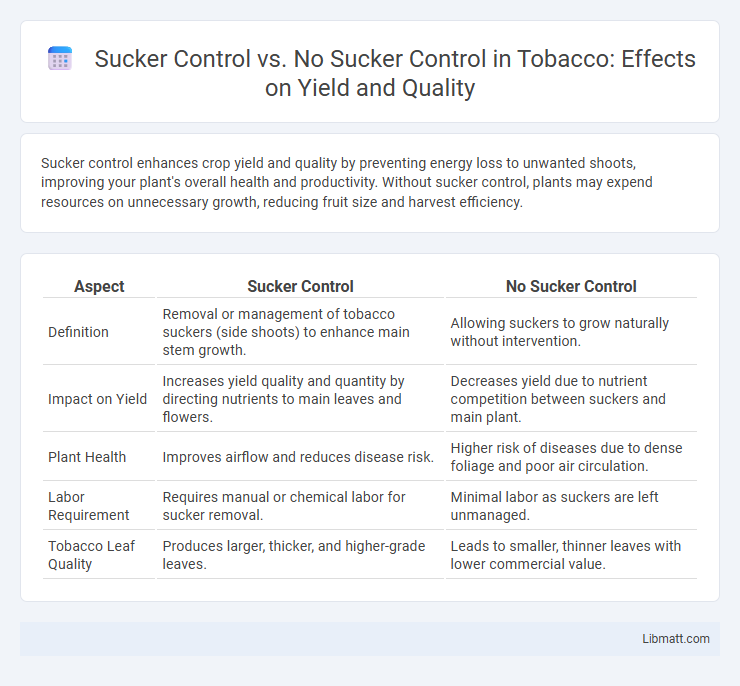Sucker control enhances crop yield and quality by preventing energy loss to unwanted shoots, improving your plant's overall health and productivity. Without sucker control, plants may expend resources on unnecessary growth, reducing fruit size and harvest efficiency.
Table of Comparison
| Aspect | Sucker Control | No Sucker Control |
|---|---|---|
| Definition | Removal or management of tobacco suckers (side shoots) to enhance main stem growth. | Allowing suckers to grow naturally without intervention. |
| Impact on Yield | Increases yield quality and quantity by directing nutrients to main leaves and flowers. | Decreases yield due to nutrient competition between suckers and main plant. |
| Plant Health | Improves airflow and reduces disease risk. | Higher risk of diseases due to dense foliage and poor air circulation. |
| Labor Requirement | Requires manual or chemical labor for sucker removal. | Minimal labor as suckers are left unmanaged. |
| Tobacco Leaf Quality | Produces larger, thicker, and higher-grade leaves. | Leads to smaller, thinner leaves with lower commercial value. |
Introduction to Sucker Control
Sucker control involves managing unwanted shoots that drain energy from the main plant, improving overall growth and fruit production. No sucker control allows these shoots to proliferate, potentially reducing your plant's vigor and yield. Effective sucker control enhances plant health by directing nutrients to primary branches and fruits.
Understanding Suckers in Plants
Suckers are vigorous shoots that grow from a plant's root system or lower trunk, often diverting energy from the main plant and reducing fruit production or aesthetic value. Sucker control involves removing these unwanted shoots to maintain plant health and improve nutrient allocation, enhancing growth and yield. Without sucker control, plants can become overcrowded, which increases susceptibility to pests and diseases, ultimately compromising plant vigor.
Sucker Control: Methods and Techniques
Sucker control methods include mechanical removal, chemical application, and cultural practices that target unwanted shoots to enhance crop health and yield. Mechanical techniques involve pruning or cutting suckers manually, while chemical control uses targeted herbicides to inhibit sucker growth effectively. Your choice of sucker control depends on crop type, labor availability, and environmental considerations for optimal plant development.
No Sucker Control: Natural Growth Approaches
No sucker control relies on natural growth approaches by allowing shoots that emerge from rootstocks or lower stems to develop freely, which can increase plant vigor and resilience in certain crops. This method reduces labor and chemical use, promoting sustainable practices and enhancing biodiversity within the planting system. While it may lead to reduced fruit quality or yield uniformity compared to sucker-controlled plants, no sucker control supports organic farming and ecosystem balance.
Impact on Plant Health and Productivity
Sucker control significantly improves plant health by reducing competition for nutrients, water, and sunlight, which results in stronger growth and increased yield compared to plants without sucker control. Without sucker control, excessive suckers can drain resources, leading to weaker plants and lower productivity. Implementing sucker control optimizes your plant's energy allocation, enhancing overall vigor and maximizing crop output.
Effects on Yield and Fruit Quality
Sucker control significantly improves yield and fruit quality by redirecting the plant's energy towards fruit development rather than excessive vegetative growth. Without sucker control, plants tend to produce more shoots, leading to reduced light penetration, lower air circulation, and increased susceptibility to diseases, which negatively impacts fruit size and sweetness. Implementing sucker management enhances your crop uniformity and overall market value by promoting larger, healthier fruits.
Pest and Disease Considerations
Sucker control significantly reduces the risk of pest infestations by removing excess growth that often harbors insects, while no sucker control allows pests to proliferate unchecked, increasing plant vulnerability. Disease management improves with controlled suckers as better air circulation minimizes fungal and bacterial infections, whereas dense sucker growth creates a humid environment conducive to diseases. You should implement sucker control to maintain healthier plants and reduce the need for chemical pest and disease treatments.
Labor and Cost Implications
Sucker control significantly reduces labor requirements by minimizing manual removal efforts, leading to lower operational costs in vineyard management. No sucker control increases labor intensity due to frequent manual pruning, which elevates overall expenses and limits efficiency. Implementing effective sucker control techniques optimizes labor allocation and reduces the financial burden associated with vineyard maintenance.
Environmental and Sustainability Aspects
Sucker control in agriculture reduces the overgrowth of unwanted shoots, minimizing the need for chemical herbicides and lowering environmental pollution. Without sucker control, increased pest control treatments can lead to soil degradation and harmful runoff affecting surrounding ecosystems. Implementing effective sucker control supports sustainable farming by promoting healthier plant growth and reducing your farm's ecological footprint.
Choosing the Right Sucker Management Strategy
Choosing the right sucker management strategy depends on crop type, growth stage, and desired yield quality, with sucker control promoting healthier plants by removing unwanted shoots that drain nutrients. No sucker control may increase labor costs and reduce fruit size due to resource competition but can be suitable in low-intensity farming systems. Effective sucker management enhances plant vigor, maximizes fruit production, and optimizes resource allocation for sustainable agriculture.
Sucker control vs No sucker control Infographic

 libmatt.com
libmatt.com